Report on the Development of UK Oil and Gas Retail Industries
VerifiedAdded on 2020/01/23
|11
|3505
|29
Report
AI Summary
This report provides a comprehensive analysis of the UK oil and gas retail industry, examining key changes and developments. It begins with an introduction to the market, followed by a discussion of key changes, including the decline in the number of petrol filling stations (PFS) and the rise of hyperma...

DEVELOPMENT IN OIL AND
GAS RETAIL INDUSTRIES
1
GAS RETAIL INDUSTRIES
1
Paraphrase This Document
Need a fresh take? Get an instant paraphrase of this document with our AI Paraphraser
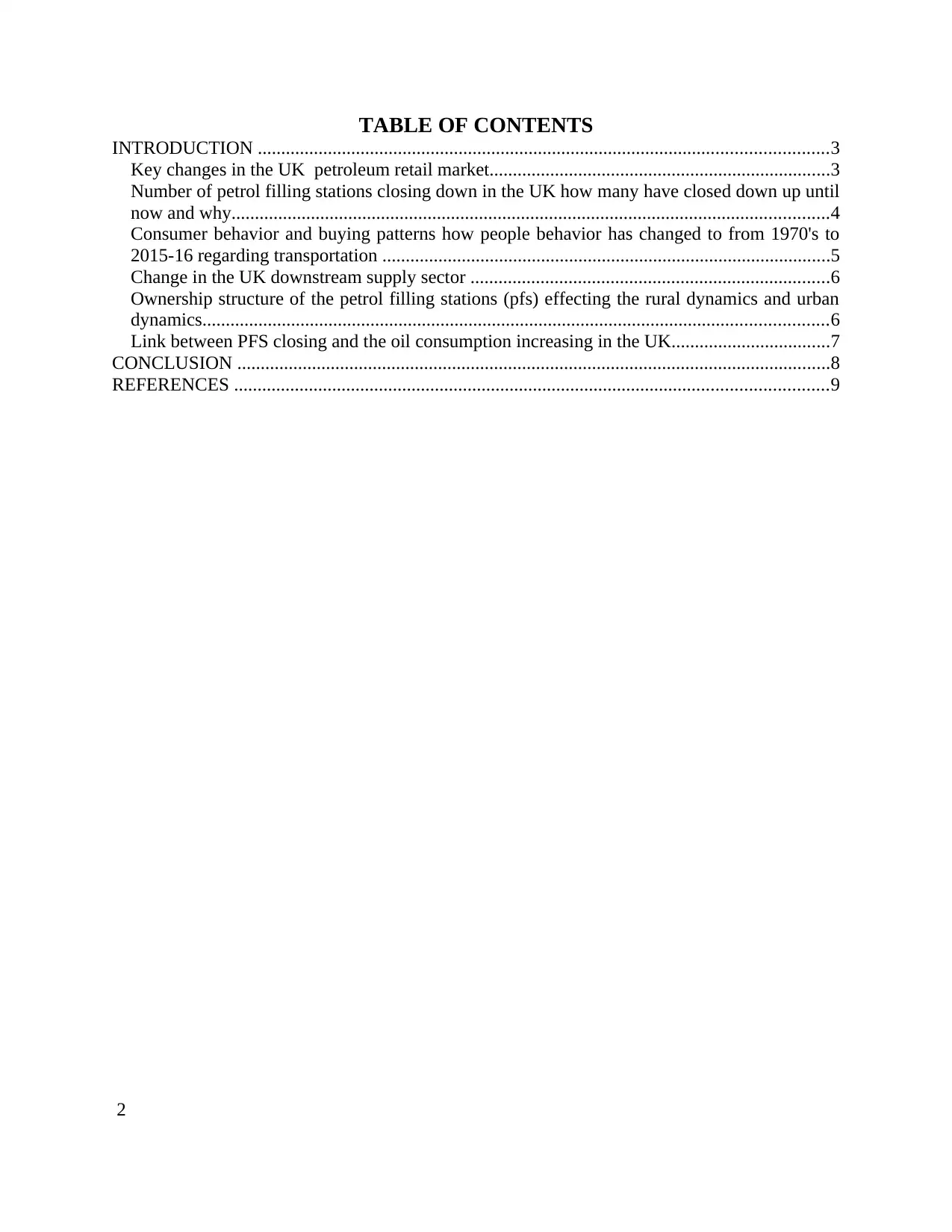
TABLE OF CONTENTS
INTRODUCTION ..........................................................................................................................3
Key changes in the UK petroleum retail market.........................................................................3
Number of petrol filling stations closing down in the UK how many have closed down up until
now and why................................................................................................................................4
Consumer behavior and buying patterns how people behavior has changed to from 1970's to
2015-16 regarding transportation ................................................................................................5
Change in the UK downstream supply sector .............................................................................6
Ownership structure of the petrol filling stations (pfs) effecting the rural dynamics and urban
dynamics......................................................................................................................................6
Link between PFS closing and the oil consumption increasing in the UK..................................7
CONCLUSION ...............................................................................................................................8
REFERENCES ...............................................................................................................................9
2
INTRODUCTION ..........................................................................................................................3
Key changes in the UK petroleum retail market.........................................................................3
Number of petrol filling stations closing down in the UK how many have closed down up until
now and why................................................................................................................................4
Consumer behavior and buying patterns how people behavior has changed to from 1970's to
2015-16 regarding transportation ................................................................................................5
Change in the UK downstream supply sector .............................................................................6
Ownership structure of the petrol filling stations (pfs) effecting the rural dynamics and urban
dynamics......................................................................................................................................6
Link between PFS closing and the oil consumption increasing in the UK..................................7
CONCLUSION ...............................................................................................................................8
REFERENCES ...............................................................................................................................9
2
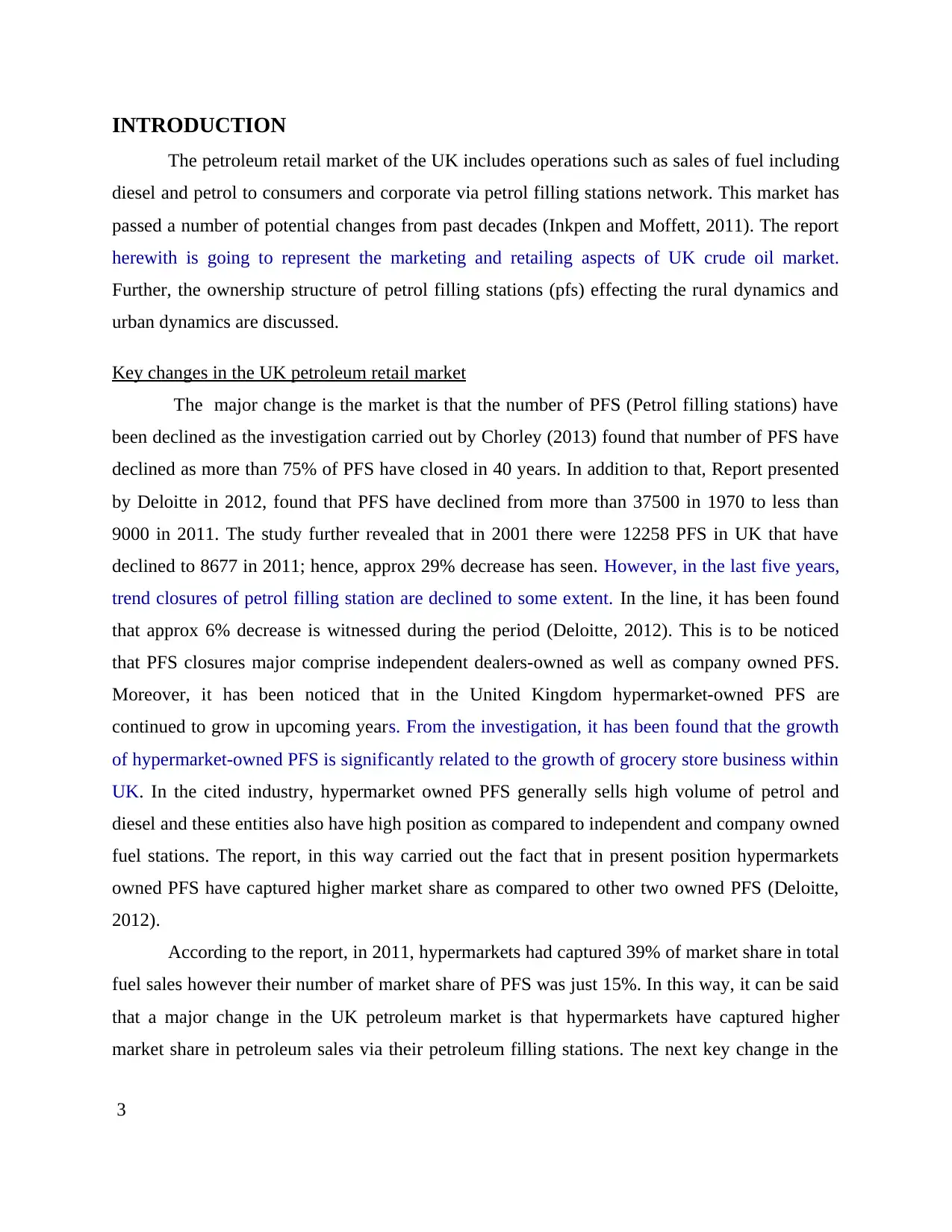
INTRODUCTION
The petroleum retail market of the UK includes operations such as sales of fuel including
diesel and petrol to consumers and corporate via petrol filling stations network. This market has
passed a number of potential changes from past decades (Inkpen and Moffett, 2011). The report
herewith is going to represent the marketing and retailing aspects of UK crude oil market.
Further, the ownership structure of petrol filling stations (pfs) effecting the rural dynamics and
urban dynamics are discussed.
Key changes in the UK petroleum retail market
The major change is the market is that the number of PFS (Petrol filling stations) have
been declined as the investigation carried out by Chorley (2013) found that number of PFS have
declined as more than 75% of PFS have closed in 40 years. In addition to that, Report presented
by Deloitte in 2012, found that PFS have declined from more than 37500 in 1970 to less than
9000 in 2011. The study further revealed that in 2001 there were 12258 PFS in UK that have
declined to 8677 in 2011; hence, approx 29% decrease has seen. However, in the last five years,
trend closures of petrol filling station are declined to some extent. In the line, it has been found
that approx 6% decrease is witnessed during the period (Deloitte, 2012). This is to be noticed
that PFS closures major comprise independent dealers-owned as well as company owned PFS.
Moreover, it has been noticed that in the United Kingdom hypermarket-owned PFS are
continued to grow in upcoming years. From the investigation, it has been found that the growth
of hypermarket-owned PFS is significantly related to the growth of grocery store business within
UK. In the cited industry, hypermarket owned PFS generally sells high volume of petrol and
diesel and these entities also have high position as compared to independent and company owned
fuel stations. The report, in this way carried out the fact that in present position hypermarkets
owned PFS have captured higher market share as compared to other two owned PFS (Deloitte,
2012).
According to the report, in 2011, hypermarkets had captured 39% of market share in total
fuel sales however their number of market share of PFS was just 15%. In this way, it can be said
that a major change in the UK petroleum market is that hypermarkets have captured higher
market share in petroleum sales via their petroleum filling stations. The next key change in the
3
The petroleum retail market of the UK includes operations such as sales of fuel including
diesel and petrol to consumers and corporate via petrol filling stations network. This market has
passed a number of potential changes from past decades (Inkpen and Moffett, 2011). The report
herewith is going to represent the marketing and retailing aspects of UK crude oil market.
Further, the ownership structure of petrol filling stations (pfs) effecting the rural dynamics and
urban dynamics are discussed.
Key changes in the UK petroleum retail market
The major change is the market is that the number of PFS (Petrol filling stations) have
been declined as the investigation carried out by Chorley (2013) found that number of PFS have
declined as more than 75% of PFS have closed in 40 years. In addition to that, Report presented
by Deloitte in 2012, found that PFS have declined from more than 37500 in 1970 to less than
9000 in 2011. The study further revealed that in 2001 there were 12258 PFS in UK that have
declined to 8677 in 2011; hence, approx 29% decrease has seen. However, in the last five years,
trend closures of petrol filling station are declined to some extent. In the line, it has been found
that approx 6% decrease is witnessed during the period (Deloitte, 2012). This is to be noticed
that PFS closures major comprise independent dealers-owned as well as company owned PFS.
Moreover, it has been noticed that in the United Kingdom hypermarket-owned PFS are
continued to grow in upcoming years. From the investigation, it has been found that the growth
of hypermarket-owned PFS is significantly related to the growth of grocery store business within
UK. In the cited industry, hypermarket owned PFS generally sells high volume of petrol and
diesel and these entities also have high position as compared to independent and company owned
fuel stations. The report, in this way carried out the fact that in present position hypermarkets
owned PFS have captured higher market share as compared to other two owned PFS (Deloitte,
2012).
According to the report, in 2011, hypermarkets had captured 39% of market share in total
fuel sales however their number of market share of PFS was just 15%. In this way, it can be said
that a major change in the UK petroleum market is that hypermarkets have captured higher
market share in petroleum sales via their petroleum filling stations. The next key change in the
3
⊘ This is a preview!⊘
Do you want full access?
Subscribe today to unlock all pages.

Trusted by 1+ million students worldwide
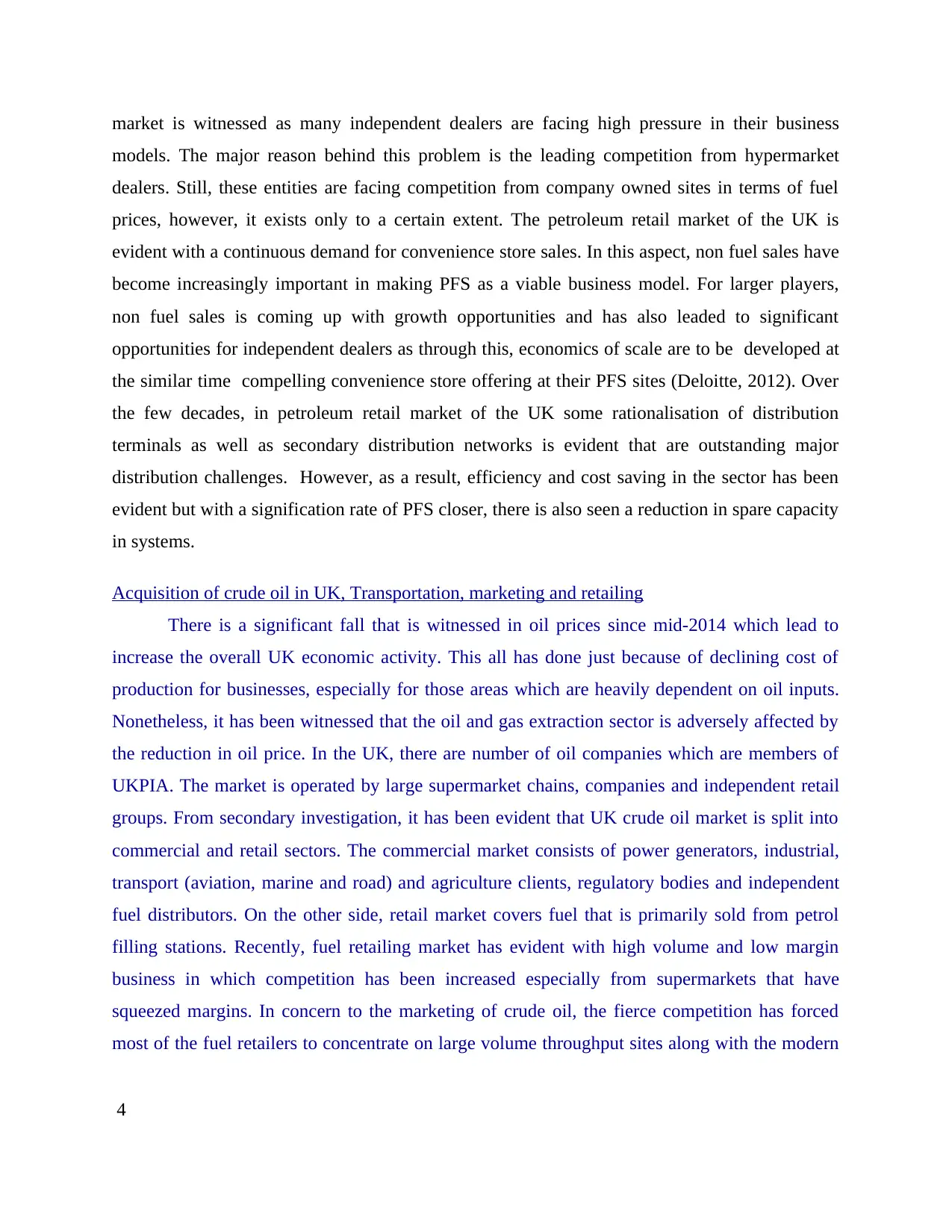
market is witnessed as many independent dealers are facing high pressure in their business
models. The major reason behind this problem is the leading competition from hypermarket
dealers. Still, these entities are facing competition from company owned sites in terms of fuel
prices, however, it exists only to a certain extent. The petroleum retail market of the UK is
evident with a continuous demand for convenience store sales. In this aspect, non fuel sales have
become increasingly important in making PFS as a viable business model. For larger players,
non fuel sales is coming up with growth opportunities and has also leaded to significant
opportunities for independent dealers as through this, economics of scale are to be developed at
the similar time compelling convenience store offering at their PFS sites (Deloitte, 2012). Over
the few decades, in petroleum retail market of the UK some rationalisation of distribution
terminals as well as secondary distribution networks is evident that are outstanding major
distribution challenges. However, as a result, efficiency and cost saving in the sector has been
evident but with a signification rate of PFS closer, there is also seen a reduction in spare capacity
in systems.
Acquisition of crude oil in UK, Transportation, marketing and retailing
There is a significant fall that is witnessed in oil prices since mid-2014 which lead to
increase the overall UK economic activity. This all has done just because of declining cost of
production for businesses, especially for those areas which are heavily dependent on oil inputs.
Nonetheless, it has been witnessed that the oil and gas extraction sector is adversely affected by
the reduction in oil price. In the UK, there are number of oil companies which are members of
UKPIA. The market is operated by large supermarket chains, companies and independent retail
groups. From secondary investigation, it has been evident that UK crude oil market is split into
commercial and retail sectors. The commercial market consists of power generators, industrial,
transport (aviation, marine and road) and agriculture clients, regulatory bodies and independent
fuel distributors. On the other side, retail market covers fuel that is primarily sold from petrol
filling stations. Recently, fuel retailing market has evident with high volume and low margin
business in which competition has been increased especially from supermarkets that have
squeezed margins. In concern to the marketing of crude oil, the fierce competition has forced
most of the fuel retailers to concentrate on large volume throughput sites along with the modern
4
models. The major reason behind this problem is the leading competition from hypermarket
dealers. Still, these entities are facing competition from company owned sites in terms of fuel
prices, however, it exists only to a certain extent. The petroleum retail market of the UK is
evident with a continuous demand for convenience store sales. In this aspect, non fuel sales have
become increasingly important in making PFS as a viable business model. For larger players,
non fuel sales is coming up with growth opportunities and has also leaded to significant
opportunities for independent dealers as through this, economics of scale are to be developed at
the similar time compelling convenience store offering at their PFS sites (Deloitte, 2012). Over
the few decades, in petroleum retail market of the UK some rationalisation of distribution
terminals as well as secondary distribution networks is evident that are outstanding major
distribution challenges. However, as a result, efficiency and cost saving in the sector has been
evident but with a signification rate of PFS closer, there is also seen a reduction in spare capacity
in systems.
Acquisition of crude oil in UK, Transportation, marketing and retailing
There is a significant fall that is witnessed in oil prices since mid-2014 which lead to
increase the overall UK economic activity. This all has done just because of declining cost of
production for businesses, especially for those areas which are heavily dependent on oil inputs.
Nonetheless, it has been witnessed that the oil and gas extraction sector is adversely affected by
the reduction in oil price. In the UK, there are number of oil companies which are members of
UKPIA. The market is operated by large supermarket chains, companies and independent retail
groups. From secondary investigation, it has been evident that UK crude oil market is split into
commercial and retail sectors. The commercial market consists of power generators, industrial,
transport (aviation, marine and road) and agriculture clients, regulatory bodies and independent
fuel distributors. On the other side, retail market covers fuel that is primarily sold from petrol
filling stations. Recently, fuel retailing market has evident with high volume and low margin
business in which competition has been increased especially from supermarkets that have
squeezed margins. In concern to the marketing of crude oil, the fierce competition has forced
most of the fuel retailers to concentrate on large volume throughput sites along with the modern
4
Paraphrase This Document
Need a fresh take? Get an instant paraphrase of this document with our AI Paraphraser

forecourt and shop facilities (Refining Britain's fuels, 2016). The transportation sector of UK has
got benefits from recent reduction in oil prices. It has not only influenced the direct savings
which are derived from lower fuel prices but also it upticks consumer spending on transportation
in a positive sense. In the present era, market of crude oil is affected by new trend which is
known as forecourt "shop" as many of the fuel retailers have established joint venture operations
with supermarket brands to design larger convenience store/fuel outlets (Deloitte, 2012). The
investigation represented that Oil became cheaper as an input which allows business to reduce
prices to attract the market and to increase the demand for their product. Enhanced aggregate
demand in economy leads to increase in downstream purchases (The impact of lower oil prices
on the UK economy, 2015).
Number of petrol filling stations closing down in the UK how many have closed down up until
now and why
According to the investigation of Boyce (2011) the number of petrol stations or PFS's is
diminishing at a dramatic pace just because the independent forecourts are struggling for
competing with the bigger fuel players and the leading supermarkets dealers who have entered in
the industry. The report carried out by the retail wholesaler Palmer and Harvey, the number of
petrol stations has plummeted to 8,500, which count was 21,000 forecourts age 20 years back.
There is a massive fall of 60% from last 20 years in the sector as many of petrol stations have
been closed just due to leading completion in the market (Deloitte, 2012). Britain has lost more
than half its petrol stations in last 15 years, however, Swathes of Scotland are found with some
smooth coverage. This is further identified that Fife has the lowest number of forecourts in whole
of the UK. From last 50-year, it has been witnessed that number of petrol stations in the UK has
plummeted because of low earning of UK people as the hard financial crisis have lead them to
motorists leave their cars at home (Ramos and Veiga 2011). The investigative revealed that from
a peak of 21,000 in the 1990s, the number of petrol stations have been decreased to 8500
forecourts within the UK. This was a lead time in which the number of petrol station has gone to
down or dipped below 9000 since the 1950s, however, in 1967's it was record high of 39,958.
According to the recent forecast made for the industry, iExperian said that the number of petrol
can drop down to 7500 in upcoming 10 years. In the similar section, Chorley (2013) has found
5
got benefits from recent reduction in oil prices. It has not only influenced the direct savings
which are derived from lower fuel prices but also it upticks consumer spending on transportation
in a positive sense. In the present era, market of crude oil is affected by new trend which is
known as forecourt "shop" as many of the fuel retailers have established joint venture operations
with supermarket brands to design larger convenience store/fuel outlets (Deloitte, 2012). The
investigation represented that Oil became cheaper as an input which allows business to reduce
prices to attract the market and to increase the demand for their product. Enhanced aggregate
demand in economy leads to increase in downstream purchases (The impact of lower oil prices
on the UK economy, 2015).
Number of petrol filling stations closing down in the UK how many have closed down up until
now and why
According to the investigation of Boyce (2011) the number of petrol stations or PFS's is
diminishing at a dramatic pace just because the independent forecourts are struggling for
competing with the bigger fuel players and the leading supermarkets dealers who have entered in
the industry. The report carried out by the retail wholesaler Palmer and Harvey, the number of
petrol stations has plummeted to 8,500, which count was 21,000 forecourts age 20 years back.
There is a massive fall of 60% from last 20 years in the sector as many of petrol stations have
been closed just due to leading completion in the market (Deloitte, 2012). Britain has lost more
than half its petrol stations in last 15 years, however, Swathes of Scotland are found with some
smooth coverage. This is further identified that Fife has the lowest number of forecourts in whole
of the UK. From last 50-year, it has been witnessed that number of petrol stations in the UK has
plummeted because of low earning of UK people as the hard financial crisis have lead them to
motorists leave their cars at home (Ramos and Veiga 2011). The investigative revealed that from
a peak of 21,000 in the 1990s, the number of petrol stations have been decreased to 8500
forecourts within the UK. This was a lead time in which the number of petrol station has gone to
down or dipped below 9000 since the 1950s, however, in 1967's it was record high of 39,958.
According to the recent forecast made for the industry, iExperian said that the number of petrol
can drop down to 7500 in upcoming 10 years. In the similar section, Chorley (2013) has found
5
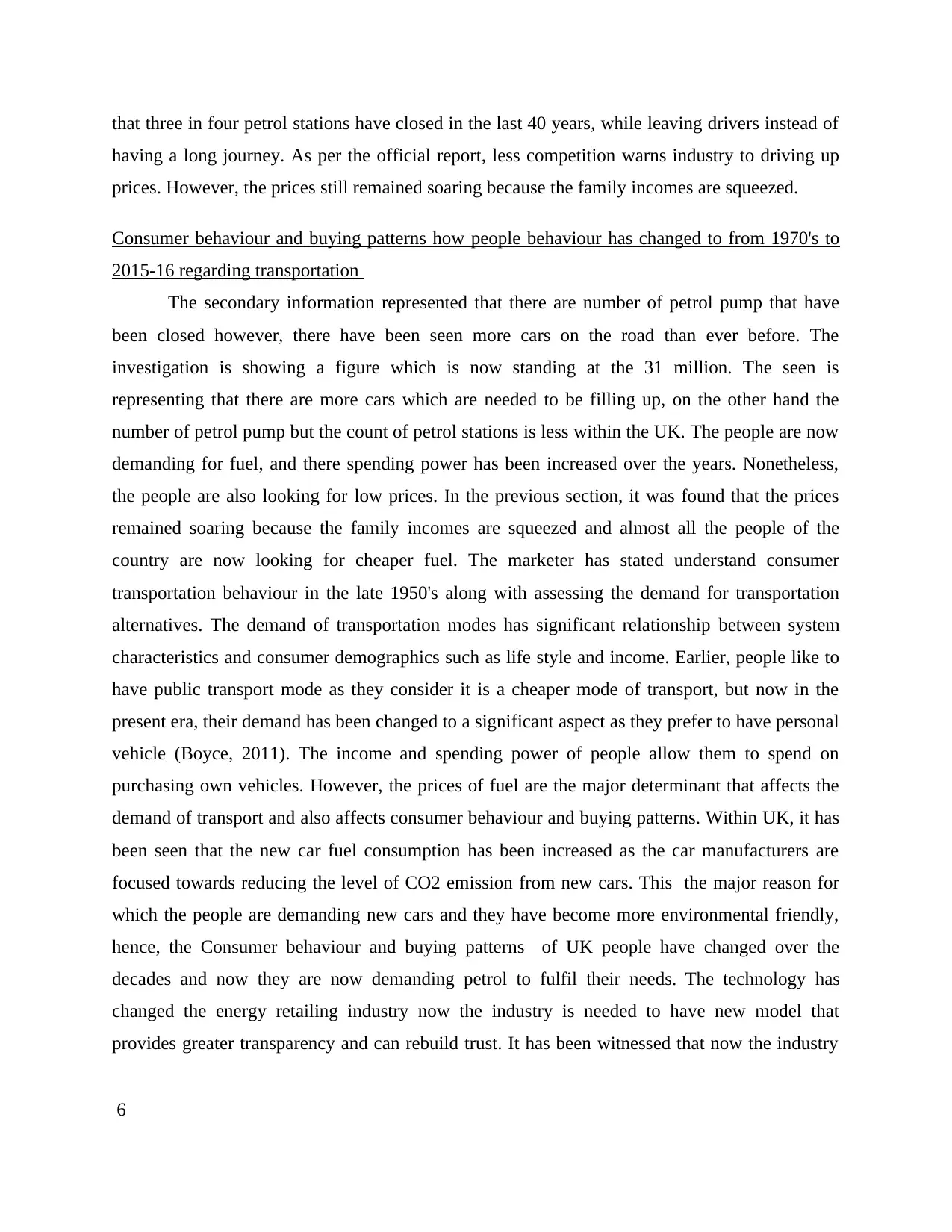
that three in four petrol stations have closed in the last 40 years, while leaving drivers instead of
having a long journey. As per the official report, less competition warns industry to driving up
prices. However, the prices still remained soaring because the family incomes are squeezed.
Consumer behaviour and buying patterns how people behaviour has changed to from 1970's to
2015-16 regarding transportation
The secondary information represented that there are number of petrol pump that have
been closed however, there have been seen more cars on the road than ever before. The
investigation is showing a figure which is now standing at the 31 million. The seen is
representing that there are more cars which are needed to be filling up, on the other hand the
number of petrol pump but the count of petrol stations is less within the UK. The people are now
demanding for fuel, and there spending power has been increased over the years. Nonetheless,
the people are also looking for low prices. In the previous section, it was found that the prices
remained soaring because the family incomes are squeezed and almost all the people of the
country are now looking for cheaper fuel. The marketer has stated understand consumer
transportation behaviour in the late 1950's along with assessing the demand for transportation
alternatives. The demand of transportation modes has significant relationship between system
characteristics and consumer demographics such as life style and income. Earlier, people like to
have public transport mode as they consider it is a cheaper mode of transport, but now in the
present era, their demand has been changed to a significant aspect as they prefer to have personal
vehicle (Boyce, 2011). The income and spending power of people allow them to spend on
purchasing own vehicles. However, the prices of fuel are the major determinant that affects the
demand of transport and also affects consumer behaviour and buying patterns. Within UK, it has
been seen that the new car fuel consumption has been increased as the car manufacturers are
focused towards reducing the level of CO2 emission from new cars. This the major reason for
which the people are demanding new cars and they have become more environmental friendly,
hence, the Consumer behaviour and buying patterns of UK people have changed over the
decades and now they are now demanding petrol to fulfil their needs. The technology has
changed the energy retailing industry now the industry is needed to have new model that
provides greater transparency and can rebuild trust. It has been witnessed that now the industry
6
having a long journey. As per the official report, less competition warns industry to driving up
prices. However, the prices still remained soaring because the family incomes are squeezed.
Consumer behaviour and buying patterns how people behaviour has changed to from 1970's to
2015-16 regarding transportation
The secondary information represented that there are number of petrol pump that have
been closed however, there have been seen more cars on the road than ever before. The
investigation is showing a figure which is now standing at the 31 million. The seen is
representing that there are more cars which are needed to be filling up, on the other hand the
number of petrol pump but the count of petrol stations is less within the UK. The people are now
demanding for fuel, and there spending power has been increased over the years. Nonetheless,
the people are also looking for low prices. In the previous section, it was found that the prices
remained soaring because the family incomes are squeezed and almost all the people of the
country are now looking for cheaper fuel. The marketer has stated understand consumer
transportation behaviour in the late 1950's along with assessing the demand for transportation
alternatives. The demand of transportation modes has significant relationship between system
characteristics and consumer demographics such as life style and income. Earlier, people like to
have public transport mode as they consider it is a cheaper mode of transport, but now in the
present era, their demand has been changed to a significant aspect as they prefer to have personal
vehicle (Boyce, 2011). The income and spending power of people allow them to spend on
purchasing own vehicles. However, the prices of fuel are the major determinant that affects the
demand of transport and also affects consumer behaviour and buying patterns. Within UK, it has
been seen that the new car fuel consumption has been increased as the car manufacturers are
focused towards reducing the level of CO2 emission from new cars. This the major reason for
which the people are demanding new cars and they have become more environmental friendly,
hence, the Consumer behaviour and buying patterns of UK people have changed over the
decades and now they are now demanding petrol to fulfil their needs. The technology has
changed the energy retailing industry now the industry is needed to have new model that
provides greater transparency and can rebuild trust. It has been witnessed that now the industry
6
⊘ This is a preview!⊘
Do you want full access?
Subscribe today to unlock all pages.

Trusted by 1+ million students worldwide
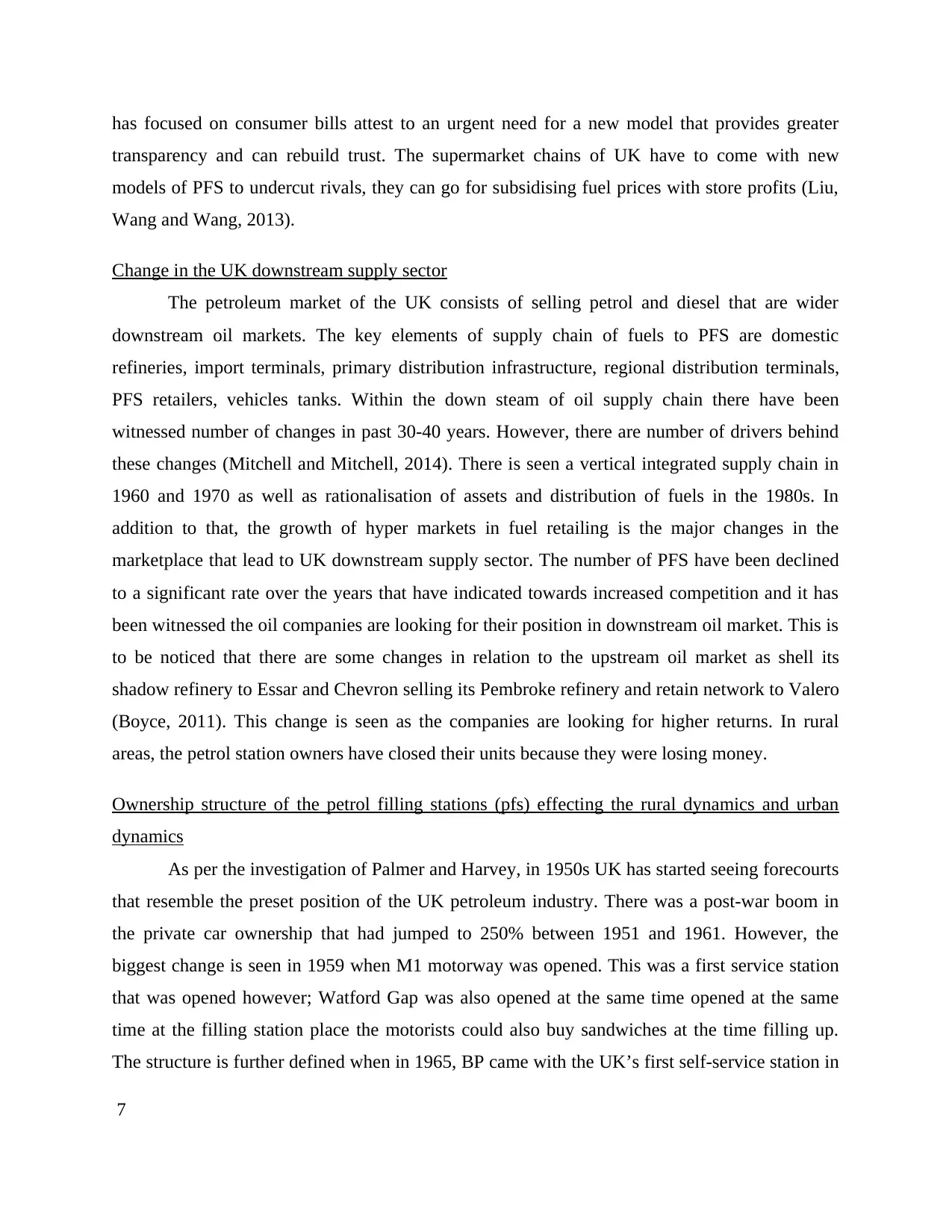
has focused on consumer bills attest to an urgent need for a new model that provides greater
transparency and can rebuild trust. The supermarket chains of UK have to come with new
models of PFS to undercut rivals, they can go for subsidising fuel prices with store profits (Liu,
Wang and Wang, 2013).
Change in the UK downstream supply sector
The petroleum market of the UK consists of selling petrol and diesel that are wider
downstream oil markets. The key elements of supply chain of fuels to PFS are domestic
refineries, import terminals, primary distribution infrastructure, regional distribution terminals,
PFS retailers, vehicles tanks. Within the down steam of oil supply chain there have been
witnessed number of changes in past 30-40 years. However, there are number of drivers behind
these changes (Mitchell and Mitchell, 2014). There is seen a vertical integrated supply chain in
1960 and 1970 as well as rationalisation of assets and distribution of fuels in the 1980s. In
addition to that, the growth of hyper markets in fuel retailing is the major changes in the
marketplace that lead to UK downstream supply sector. The number of PFS have been declined
to a significant rate over the years that have indicated towards increased competition and it has
been witnessed the oil companies are looking for their position in downstream oil market. This is
to be noticed that there are some changes in relation to the upstream oil market as shell its
shadow refinery to Essar and Chevron selling its Pembroke refinery and retain network to Valero
(Boyce, 2011). This change is seen as the companies are looking for higher returns. In rural
areas, the petrol station owners have closed their units because they were losing money.
Ownership structure of the petrol filling stations (pfs) effecting the rural dynamics and urban
dynamics
As per the investigation of Palmer and Harvey, in 1950s UK has started seeing forecourts
that resemble the preset position of the UK petroleum industry. There was a post-war boom in
the private car ownership that had jumped to 250% between 1951 and 1961. However, the
biggest change is seen in 1959 when M1 motorway was opened. This was a first service station
that was opened however; Watford Gap was also opened at the same time opened at the same
time at the filling station place the motorists could also buy sandwiches at the time filling up.
The structure is further defined when in 1965, BP came with the UK’s first self-service station in
7
transparency and can rebuild trust. The supermarket chains of UK have to come with new
models of PFS to undercut rivals, they can go for subsidising fuel prices with store profits (Liu,
Wang and Wang, 2013).
Change in the UK downstream supply sector
The petroleum market of the UK consists of selling petrol and diesel that are wider
downstream oil markets. The key elements of supply chain of fuels to PFS are domestic
refineries, import terminals, primary distribution infrastructure, regional distribution terminals,
PFS retailers, vehicles tanks. Within the down steam of oil supply chain there have been
witnessed number of changes in past 30-40 years. However, there are number of drivers behind
these changes (Mitchell and Mitchell, 2014). There is seen a vertical integrated supply chain in
1960 and 1970 as well as rationalisation of assets and distribution of fuels in the 1980s. In
addition to that, the growth of hyper markets in fuel retailing is the major changes in the
marketplace that lead to UK downstream supply sector. The number of PFS have been declined
to a significant rate over the years that have indicated towards increased competition and it has
been witnessed the oil companies are looking for their position in downstream oil market. This is
to be noticed that there are some changes in relation to the upstream oil market as shell its
shadow refinery to Essar and Chevron selling its Pembroke refinery and retain network to Valero
(Boyce, 2011). This change is seen as the companies are looking for higher returns. In rural
areas, the petrol station owners have closed their units because they were losing money.
Ownership structure of the petrol filling stations (pfs) effecting the rural dynamics and urban
dynamics
As per the investigation of Palmer and Harvey, in 1950s UK has started seeing forecourts
that resemble the preset position of the UK petroleum industry. There was a post-war boom in
the private car ownership that had jumped to 250% between 1951 and 1961. However, the
biggest change is seen in 1959 when M1 motorway was opened. This was a first service station
that was opened however; Watford Gap was also opened at the same time opened at the same
time at the filling station place the motorists could also buy sandwiches at the time filling up.
The structure is further defined when in 1965, BP came with the UK’s first self-service station in
7
Paraphrase This Document
Need a fresh take? Get an instant paraphrase of this document with our AI Paraphraser
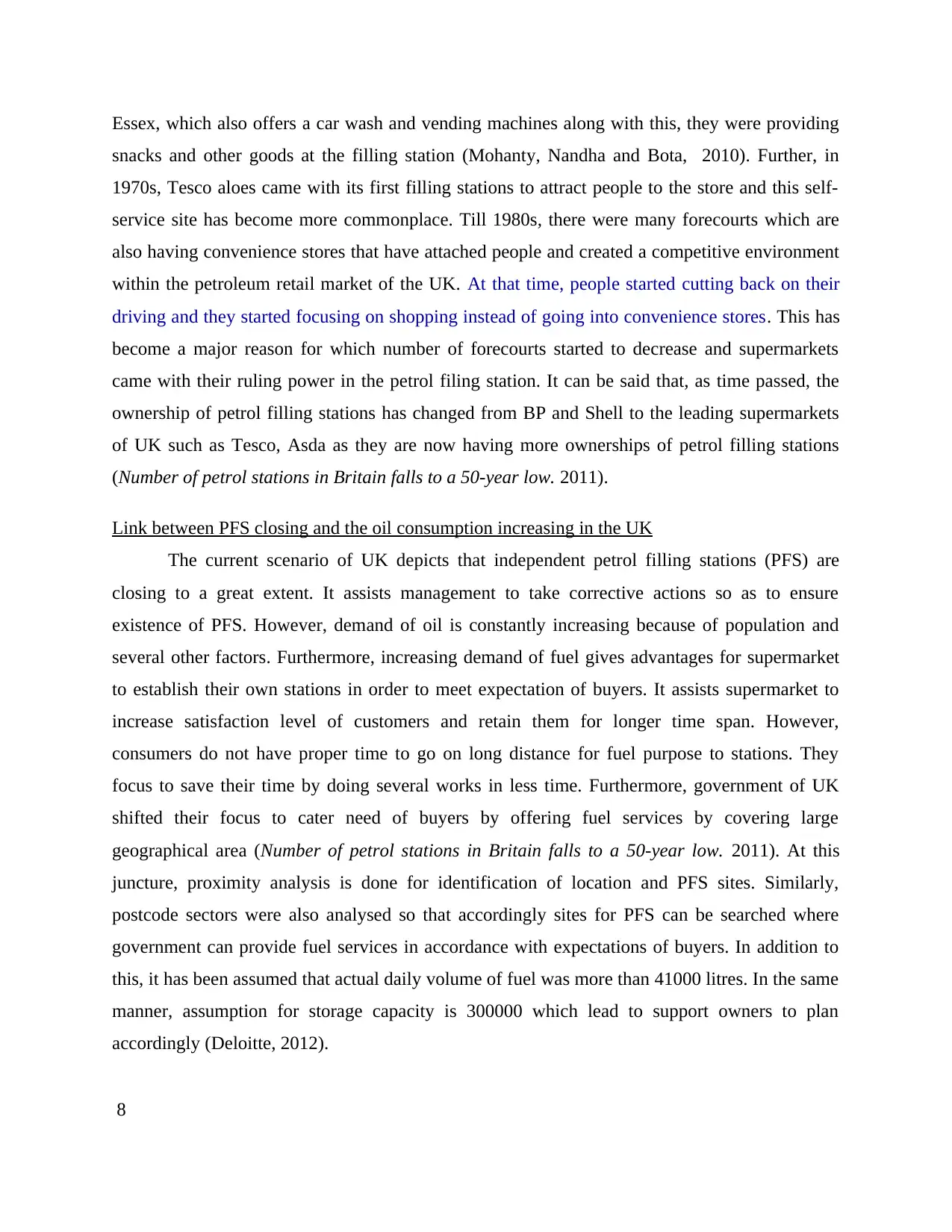
Essex, which also offers a car wash and vending machines along with this, they were providing
snacks and other goods at the filling station (Mohanty, Nandha and Bota, 2010). Further, in
1970s, Tesco aloes came with its first filling stations to attract people to the store and this self-
service site has become more commonplace. Till 1980s, there were many forecourts which are
also having convenience stores that have attached people and created a competitive environment
within the petroleum retail market of the UK. At that time, people started cutting back on their
driving and they started focusing on shopping instead of going into convenience stores. This has
become a major reason for which number of forecourts started to decrease and supermarkets
came with their ruling power in the petrol filing station. It can be said that, as time passed, the
ownership of petrol filling stations has changed from BP and Shell to the leading supermarkets
of UK such as Tesco, Asda as they are now having more ownerships of petrol filling stations
(Number of petrol stations in Britain falls to a 50-year low. 2011).
Link between PFS closing and the oil consumption increasing in the UK
The current scenario of UK depicts that independent petrol filling stations (PFS) are
closing to a great extent. It assists management to take corrective actions so as to ensure
existence of PFS. However, demand of oil is constantly increasing because of population and
several other factors. Furthermore, increasing demand of fuel gives advantages for supermarket
to establish their own stations in order to meet expectation of buyers. It assists supermarket to
increase satisfaction level of customers and retain them for longer time span. However,
consumers do not have proper time to go on long distance for fuel purpose to stations. They
focus to save their time by doing several works in less time. Furthermore, government of UK
shifted their focus to cater need of buyers by offering fuel services by covering large
geographical area (Number of petrol stations in Britain falls to a 50-year low. 2011). At this
juncture, proximity analysis is done for identification of location and PFS sites. Similarly,
postcode sectors were also analysed so that accordingly sites for PFS can be searched where
government can provide fuel services in accordance with expectations of buyers. In addition to
this, it has been assumed that actual daily volume of fuel was more than 41000 litres. In the same
manner, assumption for storage capacity is 300000 which lead to support owners to plan
accordingly (Deloitte, 2012).
8
snacks and other goods at the filling station (Mohanty, Nandha and Bota, 2010). Further, in
1970s, Tesco aloes came with its first filling stations to attract people to the store and this self-
service site has become more commonplace. Till 1980s, there were many forecourts which are
also having convenience stores that have attached people and created a competitive environment
within the petroleum retail market of the UK. At that time, people started cutting back on their
driving and they started focusing on shopping instead of going into convenience stores. This has
become a major reason for which number of forecourts started to decrease and supermarkets
came with their ruling power in the petrol filing station. It can be said that, as time passed, the
ownership of petrol filling stations has changed from BP and Shell to the leading supermarkets
of UK such as Tesco, Asda as they are now having more ownerships of petrol filling stations
(Number of petrol stations in Britain falls to a 50-year low. 2011).
Link between PFS closing and the oil consumption increasing in the UK
The current scenario of UK depicts that independent petrol filling stations (PFS) are
closing to a great extent. It assists management to take corrective actions so as to ensure
existence of PFS. However, demand of oil is constantly increasing because of population and
several other factors. Furthermore, increasing demand of fuel gives advantages for supermarket
to establish their own stations in order to meet expectation of buyers. It assists supermarket to
increase satisfaction level of customers and retain them for longer time span. However,
consumers do not have proper time to go on long distance for fuel purpose to stations. They
focus to save their time by doing several works in less time. Furthermore, government of UK
shifted their focus to cater need of buyers by offering fuel services by covering large
geographical area (Number of petrol stations in Britain falls to a 50-year low. 2011). At this
juncture, proximity analysis is done for identification of location and PFS sites. Similarly,
postcode sectors were also analysed so that accordingly sites for PFS can be searched where
government can provide fuel services in accordance with expectations of buyers. In addition to
this, it has been assumed that actual daily volume of fuel was more than 41000 litres. In the same
manner, assumption for storage capacity is 300000 which lead to support owners to plan
accordingly (Deloitte, 2012).
8
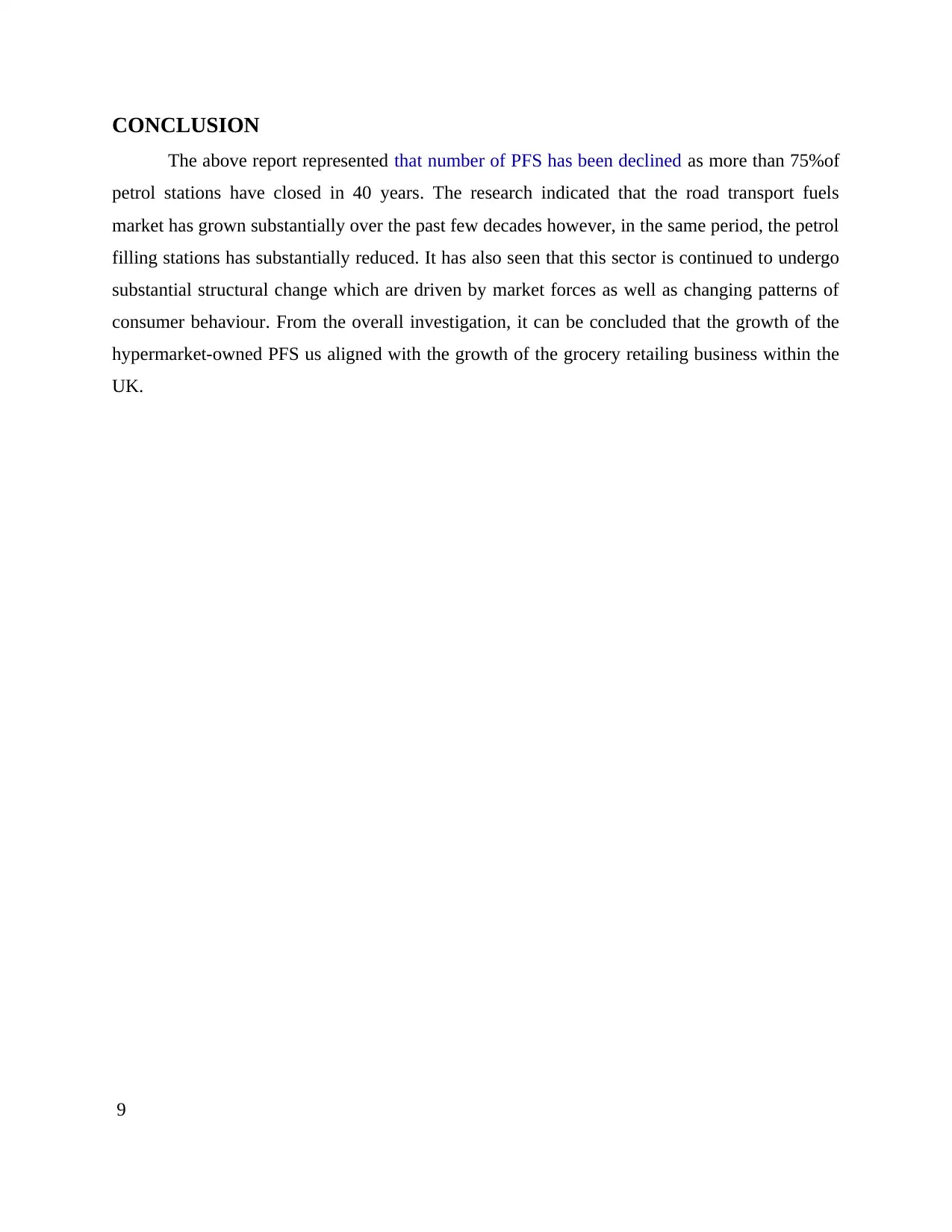
CONCLUSION
The above report represented that number of PFS has been declined as more than 75%of
petrol stations have closed in 40 years. The research indicated that the road transport fuels
market has grown substantially over the past few decades however, in the same period, the petrol
filling stations has substantially reduced. It has also seen that this sector is continued to undergo
substantial structural change which are driven by market forces as well as changing patterns of
consumer behaviour. From the overall investigation, it can be concluded that the growth of the
hypermarket-owned PFS us aligned with the growth of the grocery retailing business within the
UK.
9
The above report represented that number of PFS has been declined as more than 75%of
petrol stations have closed in 40 years. The research indicated that the road transport fuels
market has grown substantially over the past few decades however, in the same period, the petrol
filling stations has substantially reduced. It has also seen that this sector is continued to undergo
substantial structural change which are driven by market forces as well as changing patterns of
consumer behaviour. From the overall investigation, it can be concluded that the growth of the
hypermarket-owned PFS us aligned with the growth of the grocery retailing business within the
UK.
9
⊘ This is a preview!⊘
Do you want full access?
Subscribe today to unlock all pages.

Trusted by 1+ million students worldwide

REFERENCES
Books and Journals
Barth, J. M., 2013. The economic impact of shale gas development on state and local economies:
Benefits, costs, and uncertainties. NEW SOLUTIONS: A Journal of Environmental and
Occupational Health Policy. 23(1). pp.85-101.
Inkpen, A. C. and Moffett, M. H., 2011. The Global Oil & Gas Industry: Management, Strategy
& Finance. PennWell Books.
Liu, Y., Wang, S. and Wang, L., 2013. Development of rapid determination of 18 phthalate
esters in edible vegetable oils by gas chromatography tandem mass spectrometry. Journal
of agricultural and food chemistry. 61(6). pp.1160-1164.
Mitchell, J. V. and Mitchell, B., 2014. Structural crisis in the oil and gas industry. Energy Policy.
64. pp.36-42.
Mohanty, S., Nandha, M. and Bota, G., 2010. Oil shocks and stock returns: The case of the
Central and Eastern European (CEE) oil and gas sectors. Emerging Markets Review.
11(4). pp.358-372.
Ramos, S. B. and Veiga, H., 2011. Risk factors in oil and gas industry returns: International
evidence. Energy Economics. 33(3). pp.525-542.
Online
Boyce, L., 2011. Death of the petrol station: Forecourts now at half 1990s high to hit record
low. [Online]. Available through: <http://www.thisismoney.co.uk/money/cars/article-
2053699/Death-petrol-station-Forecourts-half-1990s-boom-hit-record-low.html>.
[Accessed on 4th April 2016].
Chorley, M., 2013. How 75% of petrol stations have closed in 40 years forcing drivers to travel
further and pay more to fill up tanks. [Online]. Available through:
<http://www.dailymail.co.uk/news/article-2264588/75-petrol-stations-40-years-forcing-
drivers-travel-pay-tanks.html>. [Accessed on 4th April 2016].
Deloitte, 2012. Study of the UK petroleum retail market. [Online]. Available through:
<http://www.dailymail.co.uk/news/article-2264588/75-petrol-stations-40-years-forcing-
drivers-travel-pay-tanks.html>. [Accessed on 4th April 2016].
Number of petrol stations in Britain falls to a 50-year low. 2011. [Online]. Available through:
<http://www.dailyrecord.co.uk/news/uk-world-news/number-of-petrol-stations-in-britain-
falls-1084849#pKfApqT5vO5q4kz7.97>. [Accessed on 4th April 2016].
10
Books and Journals
Barth, J. M., 2013. The economic impact of shale gas development on state and local economies:
Benefits, costs, and uncertainties. NEW SOLUTIONS: A Journal of Environmental and
Occupational Health Policy. 23(1). pp.85-101.
Inkpen, A. C. and Moffett, M. H., 2011. The Global Oil & Gas Industry: Management, Strategy
& Finance. PennWell Books.
Liu, Y., Wang, S. and Wang, L., 2013. Development of rapid determination of 18 phthalate
esters in edible vegetable oils by gas chromatography tandem mass spectrometry. Journal
of agricultural and food chemistry. 61(6). pp.1160-1164.
Mitchell, J. V. and Mitchell, B., 2014. Structural crisis in the oil and gas industry. Energy Policy.
64. pp.36-42.
Mohanty, S., Nandha, M. and Bota, G., 2010. Oil shocks and stock returns: The case of the
Central and Eastern European (CEE) oil and gas sectors. Emerging Markets Review.
11(4). pp.358-372.
Ramos, S. B. and Veiga, H., 2011. Risk factors in oil and gas industry returns: International
evidence. Energy Economics. 33(3). pp.525-542.
Online
Boyce, L., 2011. Death of the petrol station: Forecourts now at half 1990s high to hit record
low. [Online]. Available through: <http://www.thisismoney.co.uk/money/cars/article-
2053699/Death-petrol-station-Forecourts-half-1990s-boom-hit-record-low.html>.
[Accessed on 4th April 2016].
Chorley, M., 2013. How 75% of petrol stations have closed in 40 years forcing drivers to travel
further and pay more to fill up tanks. [Online]. Available through:
<http://www.dailymail.co.uk/news/article-2264588/75-petrol-stations-40-years-forcing-
drivers-travel-pay-tanks.html>. [Accessed on 4th April 2016].
Deloitte, 2012. Study of the UK petroleum retail market. [Online]. Available through:
<http://www.dailymail.co.uk/news/article-2264588/75-petrol-stations-40-years-forcing-
drivers-travel-pay-tanks.html>. [Accessed on 4th April 2016].
Number of petrol stations in Britain falls to a 50-year low. 2011. [Online]. Available through:
<http://www.dailyrecord.co.uk/news/uk-world-news/number-of-petrol-stations-in-britain-
falls-1084849#pKfApqT5vO5q4kz7.97>. [Accessed on 4th April 2016].
10
Paraphrase This Document
Need a fresh take? Get an instant paraphrase of this document with our AI Paraphraser

Refining Britain's fuels, 2016. Marketing and retailing of crude oil. [Online]. Available through:
<http://www.ukpia.com/industry_information/marketing.aspx>. [Accessed on 6th April
2016].
The impact of lower oil prices on the UK economy. 2015. [Online]. Available through:
<https://www.pwc.co.uk/assets/pdf/ukeo-oil-prices-march-2015.pdf>. [Accessed on 6th
April 2016].
11
<http://www.ukpia.com/industry_information/marketing.aspx>. [Accessed on 6th April
2016].
The impact of lower oil prices on the UK economy. 2015. [Online]. Available through:
<https://www.pwc.co.uk/assets/pdf/ukeo-oil-prices-march-2015.pdf>. [Accessed on 6th
April 2016].
11
1 out of 11
Related Documents
Your All-in-One AI-Powered Toolkit for Academic Success.
+13062052269
info@desklib.com
Available 24*7 on WhatsApp / Email
![[object Object]](/_next/static/media/star-bottom.7253800d.svg)
Unlock your academic potential
© 2024 | Zucol Services PVT LTD | All rights reserved.





